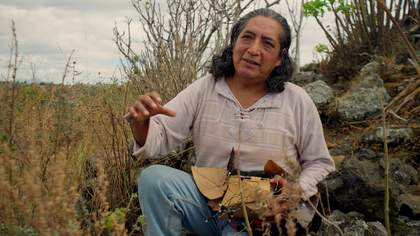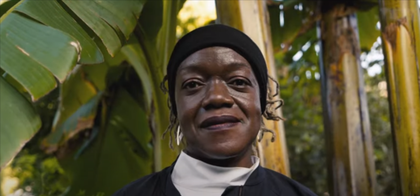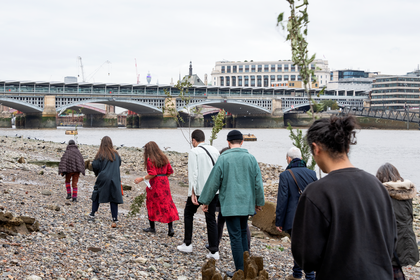This house needs cleansing. I cry a lot. I cry a lot. I have cried a lot. I am María Magdalena Campos-Pons. I am an artist. I am a profoundly conceptual thinker who brings to the realm of art a lot of language from ritual and historical practice. Ajiaco like Cuba. A casserole with many flavours in it. I am blessed with that multiplicity of flavours. My daily ritual sometimes. I jump out of bed and start drawing. I sleep with notebooks next to my table, but I work in my kitchen, I work in my bedroom, I work in every hotel that I am in the world. There is a strong feeling of urgency of need to say these are stories within myself. I feel the pain of others and. I think that my art reflects that.
I was born in Matanzas, Cuba. My heritage is complex as for many people in Cuba. Cuba is a melting pot of different cultures and in my family. Chinese, African from Nigeria and Angola and then some Spanish roots are all mixed.
Matanzas in Spanish the naming of the city means slaughter. It has this history of violence, of Indian, of Black people through slavery. Slaughter is a metaphor could be you know the labour by days of exploitation by days of oppression. I come from a tradition of Yoruba, Santeria in Cuba. I have been trying for a long time to find what is the materiality of memory and what is the materiality of dreams.
I grew up in a very strong family with a very important presence of women. My grandmother, Maria, my grandmother, Amparo, their grand aunt. Telefora. We used to get together on weekends always. Sunday was a family reunion, has been very important in my life, areas of my work and my thinking.
At 13 I visited the National Museum of Cuba for the first time and I didn't see Black people and I said I’m going to fix that. And around 17 I am with my friends in Havana and I say I’m going to put myself in that museum and many. Black faces. It took me many years, but I did that.
When I made that statement that all art is autobiographical there is no art that doesn't come from a deep part of the self of the maker. I feel responsibility to rename and to position it how I write history of art because don’tI have the privilege to study in the West because I am in the diaspora of Africa in the Caribbean. So I am centred in my position about how the narration of our history not always from the position of the coloniser. History of people with no heroes. Who defines the position of the hero? Who made the hero's story?
Matanzas Sound Map was conceived when I received the invitation for documenta 14 I was collaborating with Neil Leonard, decided to create a conversation between the history of the topography of the region and I found there unguentarias. And unguentarias are tiny little forms of glass they were used to collect tears when the man went out to crusades to wars then, I found that that was such an incredible metaphor. Collecting tears. Who collects tears? Where and why? So, I take those tiny little objects and augmented them to this gigantic size that are almost the size of the sugar fields. Neil Leonard made the soundscape for that particular piece collecting sound beds of the different regions of Matanzas. There is a band led by my cousin. Argimiro in the town of Manguito all the family members of neighbours playing there. So it is a lot of archaeological digging of what is there.
There is a discipline of making. My mother used to leave at 4am in the morning, that has been very important for me as an artist. There is no immediate reward for what you do. The reward is in that you are able and capable to sustain it.
Kamaal Malak and myself started working in a performative collaboration in 2023 He is a former member of the iconic band. Arrested. Development that have a very deep connections to conscious hip hop. They have a very interesting way of presenting an idea of rituals and a respect to ancestral energy. We both have profound spiritual and artistic life.
Sugar industry was very important in the formation of the Tate dynasty and the Tate power house and sugar is everywhere and sugar made this place be, in a way, the potency that was. We have been working for a long time with a group of dancers, poets, choreographers. This is a journey we would like to have people laughing, crying, dancing, thinking and being a part of the performance.
Pomegranate, hibiscus lemongrass, honey, sugar, jasmine. These are ancestral materials.
Pomegranate is a birthing fruit. Hibiscus it cleans your mind, it calm you down. I Am Soil. My Tears Are Water. The 25th anniversary of the creation of the Tate Modern.
From the beginning we saw that we wanted to build a sensorial space and that we wanted to bring an allegory to senses. So we wanted to work with the architecture of the space. I am very interested in the fact that the Tate not only was a place that holds two things, oil and water. I have been occupied about the state of our collective living worldwide. The destruction of peace we are in a moment of messiness. We are in a moment in which there are very sacred things that we are disrespecting. Tears is a metaphor for not only tears but salvation. Water is fertiliser. Water is giving the soil the opportunity to come out and blossom and to come out and grow.
We need to cleanse our souls. We need to cleanse our spirit, we need to cleanse our footprint with humans, with the planet.
“So. Dear Mother, allow me. Dear. Father, allow me to stay with you, In truth, gathering, in a circle of radical love”
Abundance of love, in abundance of love. In abundance of love. We still see the tragedy. We have not been given reparation for anything. I speak about that in my work and. I would speak about that until my last breath. I not do it because. I want. I have a mandate that is not in my hands.
The devaluation of historical and ancient African art calling it you know, the primitive and also the devaluation of when somebody like myself come into the scene we cannot understand her. Why could I not be understood? What is in my practice that is not legible? What is the limitation of the canon itself that is so stuck in some reading that cannot open a space to what is presented in front of it new?
I’m truthful to my feelings and a narrative and a commitment to a history of people who were no heroes, who deserve a place in the history of art, contemporary art and I am doing my best to embody that.
Watch an intimate portrait of artist María Magdalena Campos-Pons, the Afro-Cuban artist whose spiritual and conceptual work has, for more than three decades, broken barriers across photography, painting, sculpture, film, video, and performance.
We follow Campos-Pons as she prepares a special performance to mark Tate Modern's 25th anniversary, in collaboration with Kamaal Malak. Weaving ritual, music, movement, and storytelling into a meditation on radical love, justice, Campos-Pons creates spaces where silenced histories speak and resilience takes root, offering a poetic and compassionate reimagining of our shared past and present.



